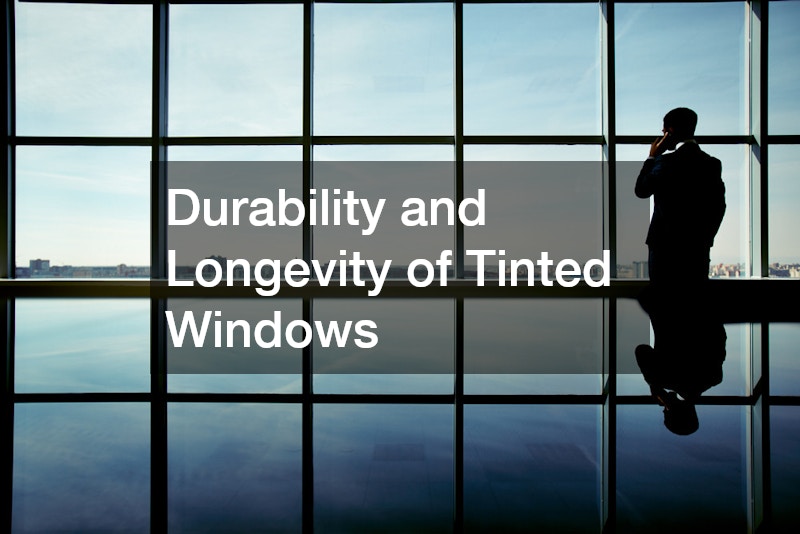Office window tinting is becoming an increasingly popular solution for businesses looking to cut down on energy expenses. This article explores how tinting your office windows can effectively reduce energy costs, improve comfort, and contribute to environmental sustainability. The growing trend of office window tinting aligns with the broader movement towards energy efficiency and sustainable practices in modern workplaces.
What is Office Window Tinting and How Does it Work?
Understanding the Basics of Window Tinting
Office window tinting involves applying a thin film to the glass surfaces of your building to reduce glare and heat from the sun. These films are typically made from polyester and are available in various shades and types, such as dyed, metalized, and hybrid films. The installation process involves precise measurement and application to ensure coverage without air bubbles, often carried out by professional technicians.
The application of window tinting not only enhances the aesthetic appeal of the building but also serves functional purposes. By selectively filtering sunlight, tinted windows allow for a comfortable interior environment while maintaining visibility. Many businesses choose specific tinting solutions based on their needs, balancing between enhancing privacy and optimizing natural light.
With daylong exposure to sunlight, unprotected office windows allow significant heat gain, especially during peak hours. Tinted windows function by reflecting and absorbing a portion of the sun’s energy, dramatically reducing the indoor temperature rise. This mechanism not only enhances comfort but also lowers the burden on air conditioning systems, thereby playing a critical role in maintaining a stable indoor climate.
Mechanism Behind Energy Efficiency
The energy efficiency of window tinting largely results from its ability to reflect ultraviolet (UV) rays and infrared (IR) radiation. By blocking these heat-producing rays, window tinting minimizes heat transfer through glass, effectively keeping indoor environments cooler. This reduction in heat gain means air conditioners run less frequently and consume less energy.
In addition to heat reflection, window tints also provide some level of insulation. The film creates a barrier that helps retain heat during colder months, which can be crucial for offices in varying climates. As a result, window tinting serves as a dual-purpose solution by conserving energy during both hot and cold weather.
The Energy Saving Benefits of Window Tinting
Reduction in Heating and Cooling Costs
Window tinting is a cost-effective approach to reducing monthly energy bills by cutting down on both heating and cooling expenses. The ability to lower the indoor temperature through reduced heat gain translates directly into less reliance on air conditioning systems. Studies have shown that tinted windows can lower cooling costs by up to 30%, providing significant savings for businesses.
During cooler months, the tint serves as an additional layer of insulation, trapping heat inside the office. This energy-saving feature helps maintain a comfortable indoor temperature without relying too heavily on heating systems. Consequently, companies experience a decline in energy consumption throughout the year, reducing their utility expenses overall.
Enhancing Building Energy Efficiency
Office window tinting is an important component of a building’s overall energy efficiency strategy. By reducing the heat exchange across windows, tinted glass solutions contribute to a more consistent internal climate, which is pivotal in meeting energy efficiency standards and building codes. Buildings with energy-efficient features are often more attractive to tenants and potential buyers, increasing property value.
Moreover, incorporating window tinting can significantly improve a building’s energy rating, making it more competitive in the real estate market. Energy ratings are fundamental in assessing a building’s carbon footprint and its alignment with sustainability standards. Businesses aiming for certification from environmental rating organizations like LEED find window tinting to be a straightforward enhancement.
Is Office Window Tinting an Environmentally Friendly Option?
Environmental Impact of Reduced Energy Consumption
Reducing energy consumption through window tinting has significant environmental benefits. As energy usage decreases, so does the carbon footprint of a building. Over time, businesses can save substantial amounts of energy, which equates to a tangible reduction in carbon emissions into the atmosphere.
This energy savings contributes positively to initiatives aimed at mitigating climate change. By reducing reliance on non-renewable energy sources, businesses partake in the global effort towards sustainable energy use. Window tinting exemplifies a practical intervention with immediate ecological benefits, positioning it as an environmentally conscious choice.
Durability and Longevity of Tinted Windows
Window tinting is renowned for its durability and long lifespan, making it a valuable investment for businesses aiming for sustainability. High-quality window films can last up to 10-15 years with proper maintenance, offering long-term energy-saving benefits. The sustained performance of these films ensures that businesses continue to reap financial and environmental rewards over the years.
Periodic evaluations and maintenance of window films can further maximize their longevity. These evaluations ensure that the tint maintains its effectiveness in light management and heat rejection over time. This longevity is essential for maintaining the structural integrity of the windows themselves, reducing the need for frequent replacements.
Office window tinting is a viable, cost-effective strategy for reducing energy bills and promoting eco-friendly practices within the workplace. By understanding its benefits and implementing it strategically, businesses can enhance comfort, reduce expenses, and contribute positively to the environment. As a seamless integration into existing buildings, window tinting represents a significant stride towards energy efficiency and sustainability.

